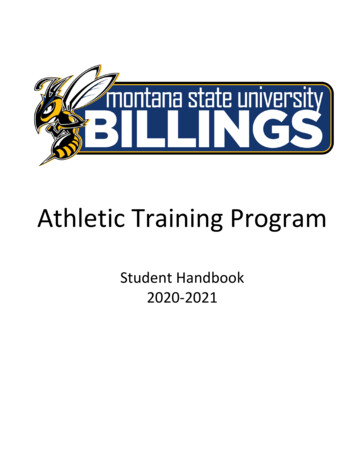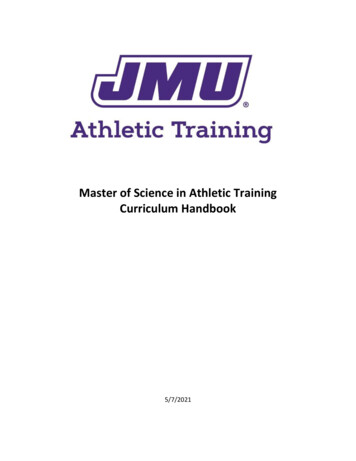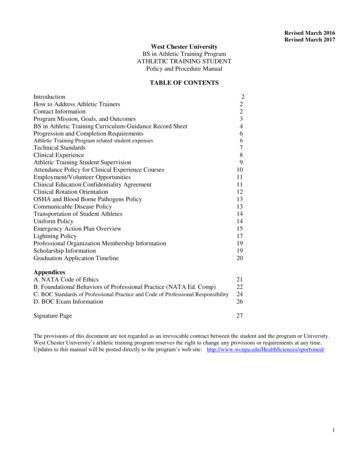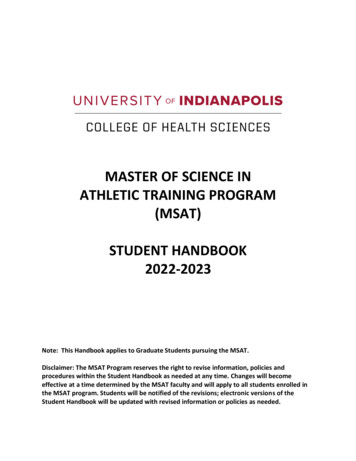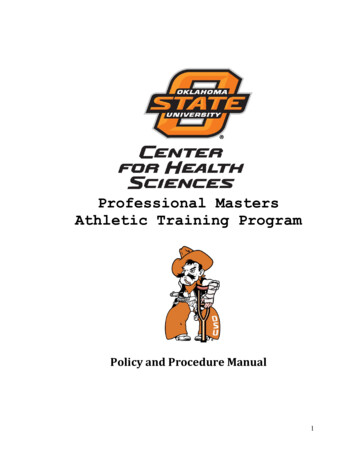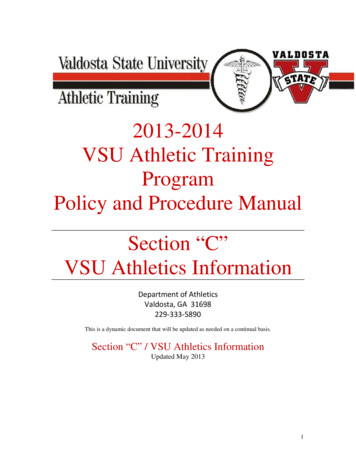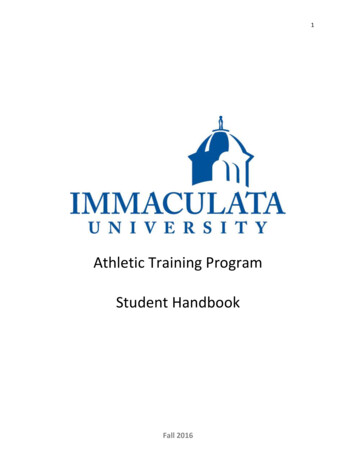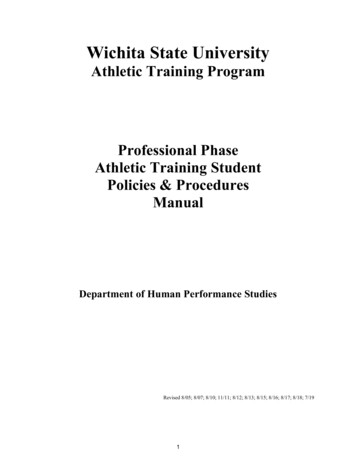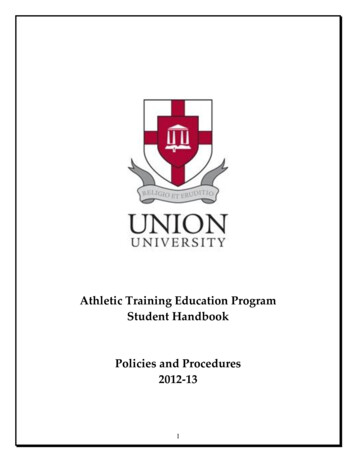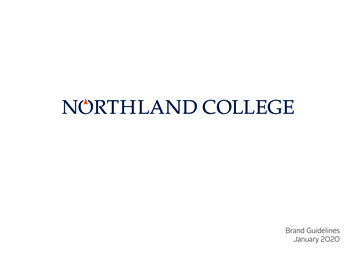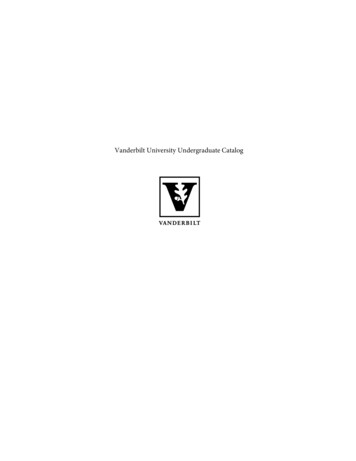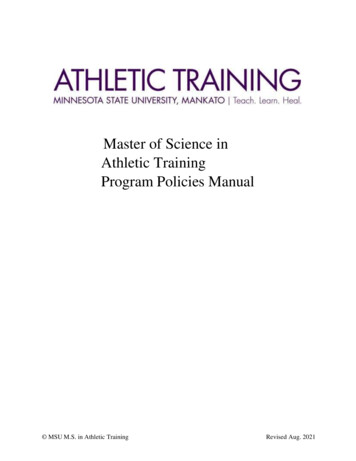
Transcription
Master of Science inAthletic TrainingProgram Policies Manual MSU M.S. in Athletic TrainingRevised Aug. 2021
Table of ContentsEach item in the table of contents is a hyperlink to the corresponding sectionTable of Contents . 2Mission & Program Goals . 1Roles & Responsibilities . 1Responsibilities of the Athletic Training Student . 1Responsibilities of the Athletic Training Education Faculty . 1Responsibilities of the Program Director. 2Responsibilities of the Clinical Education Coordinator. 2Responsibilities of the Preceptors . 2Academic Policies. 3**Important note: University policies supersede program policies and all current Universitypolicies can be found on the University website. . 3Anti-Discrimination Policy . 3University Policy. 3University Probation/Suspension Policies . 3Academic Misconduct Policy . 4College of Graduate Studies & Research Scholastic Standards . 4Clinical Experience Expectations . 5General Program Policies . 6Class Attendance. 6Professionalism . 6Ethical Conduct. 6Medical Information Confidentiality Policy. 6Communicable Disease Transmission Policy . 7Immunization Policy & Record Verification . 9Additional Fees . 9Athletic Training Classroom/Laboratory (CSB 250, 251, & HC 1702) Use Policy. 11Cell Phone Policy. 12Weather Cancellation Policy. 12Criminal Background Policy. 12Clinical Education. 13Clinical Experience Requirements. 13Athletic Training Student Hour Policy . 16 MSU M.S. in Athletic TrainingRevised Aug. 2021
Athletic Training Students Acting as a First Responder Policy . 16Definition of Supervised Clinical Hours. 17Recording of Supervised Clinical Hours . 18Costs Associated with Clinical Experiences . 18Clinical Deficiencies . 19Proficiency Assessment Policy . 19Athletic Training Student Dress Code . 19 MSU M.S. in Athletic TrainingRevised Aug. 2021
1Mission & Program GoalsIt is the mission of the Athletic Training Education Program at Minnesota State University toprovide dedicated, effective teaching, scholarship, and service to our students andto the athleticand physically active populations of the university, the community, the state, the region, and theglobal community.Program Goals1. To facilitate student knowledge and clinical skill development as the foundation for soundpractice in the profession of Athletic Training and related fields.2. To develop proficiency in the knowledge, skills, and abilities necessary in the following contentareas necessary for the practice of Athletic Training:o Evidence-Based Practiceo Prevention and Health Promotiono Clinical Examination and Diagnosiso Acute Care of Injury and Illnesso Therapeutic Interventionso Psychosocial Strategies and Referralo Healthcare Administrationo Professional Development and Responsibility3. To recognize the need for the support of clinical practice through the use of education, research,and service to the profession.4. Students will pass the athletic training Board of Certification (BOC) examination at a rate thatexceeds the accreditation requirement for both first attempt and overall, i.e., regardless ofnumberof attempts.5. To respect and treat patients as individuals, and without regard to race, color, sexualpreference, socioeconomic status, political or religious affiliation, or athletic ability.Roles & ResponsibilitiesA successful athletic training program requires that educational staff, preceptors, and students know theirrespective roles and work together to continually improve the quality of student education.Responsibilities of the Athletic Training StudentEach student officially accepted into the athletic training program is expected to follow all policies andprocedures established by the University, the College of Allied Health and Nursing, the Department ofHuman Performance, all affiliated clinical sites, and the athletic training program. Failure to abide bythese policies, procedures and guidelines may result in probation and/or dismissal from the program. Inaddition, each student is expected to maintain academic excellence, the highest professional and ethicalstandards, and to take an active role in their classroom and clinical education.Responsibilities of the Athletic Training Education FacultyFaculty in the athletic training program are responsible for classroom education, clinical instruction,student assessment, and academic advising for students enrolled in this program. It is the responsibilityof faculty to provide the athletic training student with the highest possible level of instruction, and to help MSU M.S. in Athletic TrainingRevised Aug 2021
2prepare the student to function in the clinical environment. These efforts should culminate in thedevelopment of clinical skills and knowledge sufficient to become a certified and licensed athletic trainer.Responsibilities of the Program DirectorThe Program Director is responsible for the day-to-day operation, coordination, supervision, admissions,maintenance of accreditation, and evaluation of all aspects of the athletic training program. Additionally,like all program faculty, the program director performs classroom instruction, clinical instruction, studentassessment and academic advising. These efforts, on the students’ behalf, should culminate in thedevelopment of clinical skills and knowledge sufficient to become a certified and licensed athletic trainer.The Program Director is responsible to the Department Chair and the Dean of the College of AlliedHealth and Nursing.Responsibilities of the Clinical Education CoordinatorThe Clinical Education Coordinator is responsible for coordinating athletic training student clinicalexperiences, including the maintenance and development of varied clinical settings both on and offcampus; classroom and clinical instruction and student assessment; assessment of program preceptors andto a limited degree to supervise students in a clinical setting. These efforts, on the students’ behalf,should culminate in the development of clinical skills and knowledge sufficient to become a certified andlicensed athletic trainer. For the purposes of program coordination, the Clinical Coordinator isresponsible to the Program Director and the Department Chair.Responsibilities of the PreceptorsA Preceptor is a faculty or affiliated site staff member who provides direct supervision and instruction ofstudents in the clinical aspect of the athletic training educational program. A preceptor shall have acurrent license in their profession, and if an athletic trainer, BOC recognition as a Certified AthleticTrainer. Additionally, the preceptor shall possess a NPI number with the appropriate healthcare fielddesignator. The preceptor should also possess a strong academic orientation, demonstrated clinicalteaching skills, and a sincere interest in the professional preparation of athletic training students.Demonstrated involvement in athletic training and sports medicine through publications, public speaking,research, and membership in related professional organizations is highly desirable.Preceptors are responsible for a large portion of the student's educational experience. Students learn, inpart, by doing. Experience is a rich resource, yet experience needs to be individualized and guided.Allowing the student to develop their experiences through "guided self-direction" will be a key for asuccessful clinical experience. Every setting, from the athletic training facility to the practicefield/court/track/arena, to game situations, is a learning environment. The Preceptor should: 1) providethe student with an orientation for each setting; 2) provide adequate and equitable opportunities forclinical instruction, including cognitive and psychomotor skills; 3) report any student misconduct,policy/procedure violations, or gross clinical deficiencies to the program director and/or clinicaleducation coordinator; 4) provide continuous and ongoing evaluation of student performanceremembering that student performance should be consistent with their current coursework; 5) only allowthe student to perform skills for which they have been evaluated both clinically and didactically; 6) allATs are taught, and utilize techniques in slightly different ways, the preceptor should explain anydifferences in technique by using sound empirical evidence. Variety in clinical experience is a valuableresource; however, the student must understand the logic behind the differences. The preceptor shouldrefrain from making statements such as "that’s wrong,this is the right way, " or "you were taught wrong."Instead, try to use phrases such as "have you thought about doing it this way," or “here is a method that Ilike to use because " MSU M.S. in Athletic TrainingRevised Aug 2021
3Additional recommendations to the preceptor for the enhancement of the student's clinical experience: 1)conduct discussions or "rounds" regarding patient injury/illness status and progress; 2) review materialon a thematic basis (in addition, the program director and faculty will periodically let you know what thestudents are currently covering in class so you may coordinate); 3) review case studies; 4) require thestudent to present cases to, and assist the team physician; 5) present the student with scenarios; 6) requirethe student to demonstrate proficiency in various skills and with various equipment; 7) require thestudents to teach/review with each other; 8) allow the student to discuss athlete status and progress withthe coaching staff; 9) help students to think critically, and to understand your thought process andphilosophy regarding decision making; 10) allow the students to travel whenever possible.**Important note for Preceptors and Students: Remember that all preceptors’ primary responsibilityis the provision of health care services to patients/student-athletes, while the Athletic Training ProgramDirector is responsible for all aspects of the educational program. Any questions regarding studentathlete health care should be directed to the preceptors. All questions regarding the educational program,the students, and their clinicaland didactic education should be directed to the Program Director orClinical Education Coordinator. Any questions or concerns involving both aspects, i.e., patient healthcare and athletic training student education, should be brought to the attention of the preceptor and theProgram Director or the preceptor and the Clinical Education Coordinator.Academic Policies**Important note: University policies supersede program policies and all current University policiescan be found on the University website.Anti-Discrimination PolicyMinnesota State University, Mankato is committed to a policy of nondiscrimination in employment andeducation opportunity. No person shall be discriminated against in the terms and conditions ofemployment, personnel practices, or access to and participation in programs, services, and activities withregard to race, sex, color, creed, religion, age, national origin, disability, marital status, socioeconomicstatus, sexual orientation, or membership or activity in a local commission as defined by law.University PolicyThe activities of the University are administered in accordance with a variety of federal and state laws,MnSCU Board policies, assorted rules and regulations, and staff and student rights and responsibilities.Individuals may consult the following university publications for detailed descriptions of applicablepolicies and procedures: "The Basic Stuff, " The Faculty and Staff Handbook," and the "MNSCU Manualof Policies and Procedures." University policies can also be found online in the bulletin the studentcame into the program under. For more information concerning applicable university policy, contact theoffice of the Vice President for Academic Affairs.University Probation/Suspension PoliciesThe University Policies governing “satisfactory Academic Progress, Probation, Probationary Status,Academic Misconduct, Suspension, Suspension Status” as stated in the University Bulletin are in effect.The student should refer to the bulletin for complete review of these policies. MSU M.S. in Athletic TrainingRevised Aug 2021
4Academic Misconduct PolicyAcademic misconduct includes copying, plagiarism, or other forms of cheating consistent with the "BasicStuff" student handbook. Academic misconduct may result in probation, or dismissal from the program,and may carry additional penalties regarding university policy.Note: For these and other policies the ATP always refers to the most current version of the applicableUniversity policy.College of Graduate Studies & Research Scholastic StandardsAll graduate studies policies available at: lasticstandards/ The accumulation of grades below 3.0 in more than two courses of three or more credits eachor Incomplete/In-Progress in more than three courses of two or more credits, or a combination of theabove in four courses excluding thesis/alternate plan paper credits removes the student from degreestatus.The Dean of the College of Graduate Studies and Research will monitor the academic standing of allgraduate students each semester and take the following actions based on the review of the graduatestudents' semester ending grade reports. A student who fails to meet the academic standards may berequired by the Dean of the College of Graduate Studies and Research to withdraw from the university.Individual academic programs may have published retention and dismissal policies that differ from thosenoted below. In these cases, the departmental policy will supersede the general university policy.Students receiving financial aid (excluding non-federally funded University graduate assistantships) mustabide by federal, state, and institutional policies, including but not limited to satisfactory academicprogress standards. For additional information please see the web page of the Student Financial ServicesOffice.Academic warning letters will be sent to graduate students who receive a grade of less than 3.0, an In Progress (IP), or Incomplete (I) in any graduate course of 2 credits or more, or who have a cumulativegrade point average of less than 3.0.Probation letters will be sent to students who received an academic warning letter the previous term andwho have subsequently failed to demonstrate significant improvement in their academic record. Whileunder Academic Warning status, students who receive a grade of less than 3.0, a grade point average forthe term of less than 3.0, a cumulative grade point average of less than 3.0, or an In-Progress orIncomplete in excess of four graduate courses of 2 credits or more will be placed on probation.Dismissal letters will be sent to all students who were placed on probation the previous term and whofailed to demonstrate a significant improvement in their academic record and received a grade pointaverage for the term less than 3.0, or a grade of less than 3.0, IP, or I in excess of four graduate courses of2 credits or more.No grade lower than a "C" is counted for graduation credit, but all grades earned (including Ds and Fs)are counted in determining the grade point average. Graduate courses may be repeated but credit for thecourse is applicable toward the degree only once. However, all grades earned for that course shall be usedin calculating the grade point average. MSU M.S. in Athletic TrainingRevised Aug 2021
5A student's work in any course will be evaluated in accordance with the following system of letter grades:A, B. C, D, F, N, and P."A" represents work of definitely superior quality."B" represents a level of performance that is above average."C" represents a below-average level of performance."D" represents unacceptable performance."F" represents unacceptable performance."AU" represents that a course has been audited. Audit courses do not satisfy program requirements, arenot used in determining the grade point average, and cannot be applied to a degree. Tuition and fees,however, are paid.Academic progress is monitored by the CGSR Director of Graduate Studies and Research and by programfaculty. Program faculty will monitor academic progress each semester both via instructing athletictraining courses but also at the end of each semester by obtaining an unofficial transcript for each studentandmaintaining that unofficial transcript in each student’s file folder which is kept online with passwordprotected access only.’Clinical Experience ExpectationsThe Athletic Training Student must:1.Fulfill all program requirements for clinical hours/experiences,2.Must participate in all scheduled hours/experiences as assigned by the CEC andpreceptor(s),3.Academics (athletic training classes) take priority over clinical experiences4.Clinical hours and scheduled events must take priority over outside activities or work,staff will schedule around (within reason) personal needs such as weddings, familyengagements, work, etc. (see "Clinical Experience Requirements")5.Appropriate dress, as required by program faculty and preceptor(s) will include uniformshirts, name tags, MSU Athletic Training apparel purchased by staff or students, or otherfor special events. Inappropriate dress includes torn or dirty clothing, tights, clothingadvertising alcohol, bars or in otherwise questionable taste. MSU Athletic Trainingapparel must be worn while working during open hours. All clothing must be functional.The student should be able to perform all duties without restriction. (see "Student DressCode")6.Athletic Training jackets and clothing should not be worn for outside activities that maybe considered unprofessional, such as parties and bars, etc.7.All athletic training students are expected to participate and to conduct themselves withinthe NATA and BOC Codes of Professional Conduct, (see "NATA Code of Ethics). MSU M.S. in Athletic TrainingRevised Aug 2021
6Clinical ProbationAll students are expected to follow clinical experience requirements. Failure to do so will, after the firstviolation, result in a written warning to be kept as a part of the student's record. A second violation willresult in five (5) weeks of probation. A third failure to meet clinical hours/experience requirements willresult in dismissal from the Athletic Training Program. Since the clinical experiences are a requirement ofclinical coursework (HP 584, 585, 684, 685), any probation will adversely affect the student’s grade.Thus,the student may receive a lower grade, an incomplete, or a failing grade, see Academic Progressabove.NOTE: A student who knowingly violates program policies may be placed directly on probation ordismissed from the program.General Program PoliciesClass AttendanceAlthough faculty may establish their own attendance policies, students are expected to prepare for, attend,and participate in scheduled classroom, laboratory, and clinical sessions. Athletic training students willnot be excused for team travel from any athletic training courses where educationalcompetencies/proficiencies are being introduced.ProfessionalismFaculty, staff, and students are expected to act professionally in the classroom, laboratory, and clinicalsettings, and in accordance with the professional ethics and standards of practice established by theNational Athletic Trainer's Association, the Minnesota Board of Medical Practice, and the BOC. Thisincludes appropriate and consistent action with regard to all settings and policy enforcement, dress, andconduct. Athletic training students are viewed as an extension of and representative of the Universitytherefore the highest professional standards are expected.Ethical ConductAll Athletic Training Students are expected to act professionally and ethically at all times, strictlyadhering to the NATA’s Code of Ethics and the BOC Standards of Professional Practice.Medical Information Confidentiality Policy“Confidential Health Care Information” is defined as all information (verbal, written, digital) relatingto a patient’s health care history, diagnosis, condition, treatment, or evaluation obtained from a healthcare provider or staff person in contact with a patient. It is the responsibility of Athletic TrainingEducation, through all of its students, to safeguard the medical information on each patient, whateverform the information may come to knowledge (i.e., medical records, billing slips, appointment schedules,verbal, etc.).All information regarding a patient’s medical conditions and treatments is confidential. This privilegedinformation shared between them represents the essence of the special relationship between the patientand the health care provider, and as such, the information in the patient’s records, appointment logs,billing office, etc., must be protected from unauthorized disclosure. MSU M.S. in Athletic TrainingRevised Aug 2021
7As an athletic training student whose clinical experiences require working with confidential health careinformation, the following shall apply: The student shall read a medical record only as their position requires it.The student shall use this information only as their position requires it.The student may discuss the information only as their position requires it.The student must treat all such information impersonally as part of the day’s work.As a student working directly with confidential health care information, I have been made aware by mysupervisor that there are regulations pertaining to the confidentiality of health care information, and underno circumstances shall any information leave the premises either written or verbally, concerning anypatient without that patient’s written informed consent.Students will complete documentation that asks them to attest to the following statement regardingmedical confidentiality:“I understand and agree that in the performance of my duties as a student at Minnesota State University,Mankato I will hold all health care information in confidence and that violation of this confidentiality willresult in disciplinary action (in accordance with program policy), as well as outside civil and/or criminalpenalties, up to and including a fine and/or imprisonment.”Communicable Disease Transmission PolicyThe purpose of this policy is to protect the health and safety of the students enrolled in the AthleticTraining (ATP) Program as they participate in the didactic and clinical education experiences required bythe M.S. in Athletic Training degree program. It is designed to provide students, preceptors, and facultywith a plan to assist in the management of students with infectious diseases as defined by the Centers forDisease Control and Prevention (CDC). This policy was developed using the recommendationsestablished by the CDC for health care workers and has been adopted, with permission, from theDuquesne University Department of Athletic Training; the recommendations were established on thebasis of “existing scientific date, theoretic rationale, applicability and potential economic impact.”Guidelines for Prevention of Exposure and Infection1.2.3.All students must attend/participate in required OSHA and Blood-borne pathogen trainingannually to learn,practice, and be evaluated as successfully performing all skills and tasks thatwill assist themin limiting their exposure in health care settings.To limit exposure, students are required to use proper hand washing techniques and practicegood hygiene at all times.Students are required to use Universal Precautions AT ALL TIMES when functioning ashealth care professional students in health care settings and/or working with potential sourcesof infectious disease.Guidelines for Managing Potential Infection1.2.A student who has been exposed to a potential infection before, during, or after a clinicalexperience should report that exposure to their preceptor, as well as the CEC and PD.A student, who demonstrates signs of infection or disease that may place them and/or theirpatients at risk, should report that potential infection or disease immediately to Health Service(21 Carkowski Commons, 389-6276). If a student is in doubt of their health risk,that studentshould immediately report to Health Service for evaluation by a qualified health MSU M.S. in Athletic TrainingRevised Aug 2021
83.4.5.6.7.professional. A student may utilize their family physician; however, the same requirementsand notifications yielded from the Health Service will be required of the personal physician.If a student feels ill enough (e.g., fever, diarrhea, other acute symptoms) to miss more thanone day of class or clinical experience, that student should be evaluated by the HealthService ortheir family physician.Upon review by Health Service or the personal physician, the student must make it knownthat they are/they an Athletic Training student and that they are required to furnish theProgramDirector and Clinical Education Coordinator with notification of their health statusand ability to participate in the required academic and clinical activities of the educationalprogram.Upon receipt of the health status notification from Health Service or the family physician, thestudent must present that notification to the Program Director or the Clinical EducationCoordinator whowill inform the other appropriate Athletic Training faculty who (incompliance with HIPAA (Health Insurance Portability & Accountability Act)) are required toknow the student’s health status. The health notification will be placed in the student’s filewhich is kept online with password protected access only .The student is required to notify their preceptor of missed clinical experiences; this need tomiss clinical time will be confirmed by the Clinical Education Coordinator with thedesignated preceptor. The student will assume responsibility for the notification of theStudent Affairs office (389-1819) so that office may off
Responsibilities of the Athletic Training Student Each student officially accepted into the athletic training program is expected to follow all policies and procedures established by the University, the College of Allied Health and Nursing, the Department of Human Performance, all affiliated clinical sites, and the athletic training program.
